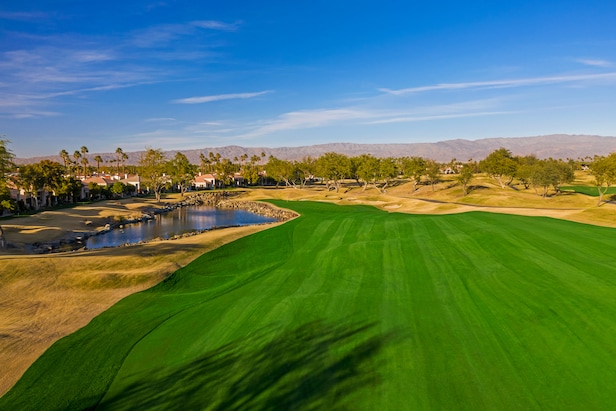The Stadium Course at PGA West was conceived as a California version of the Players Stadium course at TPC Sawgrass—but harder. The course opened in 1984, an era when difficulty was often conflated with greatness, and with PGA West, Pete Dye was evidently trying to build the greatest course on earth. He emptied the toolbox with the design, digging down into the desert of La Quinta, using the material to construct perimeter spectator mounds, eight ponds lined with rocks and bulkheads, wild moguls through the fairways and greens, and deep, steep-faced bunkers.
When the PGA Tour came to the Stadium Course for the first time in 1987 for what was then the Bob Hope Chrysler Classic, the response was not positive. The players were nearly unanimous in their dislike of the course (like Peter Jacobsen, who said: “This course has set back golf a lot”). Pros threatened to petition the tour and commissioner Deane Beaman for the tournament not to return. It didn’t, until 2016. Attitudes and outlooks have mellowed the last 30-plus years, and while the course no longer makes players apoplectic (the field consistently shoots under par), holes like the 11th still manage to confound tour pros, who are used to having their way with par 5s.
The 11th is a long, straight par 5 that appears rather basic compared to the surrounding flair of PGA West’s Stadium Course. A ridge of spectator mounds runs the length of the hole on the right mirrored by a low stretch of long rough on the left. An ornamental, rock-banked pond sits below the putting surface on the left, but the critical feature of the hole is the oceanic fairway contour short of the green and an elevated plateau that dominates the right side of the second landing zone beginning about 140 yards from the green.
The 11th is a bit of an enigma—it looks gettable from the tee with a 40-yard-wide fairway, and the pond left of the green imminently avoidable (during the last five tournaments, only six balls have been hit into the water on the second shot). Yet the green remains elusive to even the biggest hitters due to the fairway contours short of the green that kill and deflect incoming attempts. Getting short approaches and pitch shots close is also tricky because they’re played from uneven lies up to and elevated putting surface (above). It’s simply not a hole that can be overpowered.
Though the fairway movements in front of the green is what’s most interesting, making it nearly impossible to run up second shots, this heat map shows an additional defense—a false front edge that dips down toward the fairway. Careless approach shots can also flow off the green to the right into a low chipping area. Again, these are subtle but brilliant design characteristics that demand precision from the best players in the world.
Since The American Express returned to the Stadium Course in 2016, only 10 players have reached the 11th green with their second shot. While the hole plays under par with a 4.78 stroke average, it has yielded 34 fewer birdies than the course’s other par 5s.
(Green mapping courtesy of StrackaLine)


